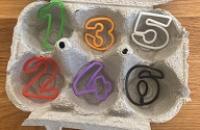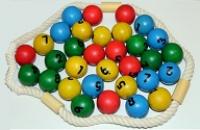Solving problems





Children often enjoy the challenge of being asked to help solve a problem, especially if it has big numbers and involves injustice.
Adults could introduce story problems with a large group of three and four-year-olds. The story can involve sharing with toy characters and a familiar context which will provoke mathematical discussion, language and reasoning. Having another character come along creates a new problem, and remainders present options involving fractions, addition or subtraction.
The Activity
Pirate Panda has taken all the treasure, 20 golden coins. Cat, Dog and Rabbit jump about excitedly. "Can we have some too?"
"No! No! No!" says Pirate Panda.
Can the children suggest what Panda ought to do?
Encouraging mathematical thinking and reasoning:
Describing
Is it fair?
Have they all got the same amount?
Is it fair now?
Reasoning
Why is this fair/not fair? How do you know?
Opening Out
What if we give them another one each?
Sheep comes along - what should we do now?
Bear comes too, so what could we do about the remainder?
What else could we do?
Recording
Could you draw a picture to show Panda what to do in order to be fair?
The Mathematical Journey
Counting:
- cardinality - the last number gives how many there are
- counting for a purpose - to see if everyone has the same number
Number symbols:
- matching numerals to amounts, or recording amounts informally
Comparing:
- saying who has more or not as many
- saying which numbers are more or less than others
Adding and subtracting:
- saying how many there will be if we give them one more each
- saying how many there will be if we take one away
Dividing:
- sharing practically, using one-to-one and many-to-one
- understanding how 'dealing' results in equal shares and the same number each
Problem solving:
- starting again and redistributing
- using adding and subtracting to make it fair
- creating fractions to solve a remainder problem
- finding alternative solutions
- checking to make sure they all have the same
Development and Variation
You could start the story with Panda sharing unfairly, provoking the children to comment. The numbers chosen determine the level of challenge: 20 shared between four toys encourages counting up to 5 for younger children. You might simplify the problem by having two and then three characters, but use larger numbers of characters for expert counters.
Deliberately choosing numbers which create remainders, like 4 or 5 shared between three, offers opportunities for alternative solutions such as fractions, subtracting some or adding some more.
Problems such as 7 shared between four offer more challenging multistep solutions.
Toys and objects could fit with a current interest, such as a teddy bear party.
Use a real context such as sharing fruit. This would encourage discussion of fractions, especially if there was a 'bigger half'!
Other contexts include sharing bulbs between containers or sharing resources for artwork. You could use Numicon or ten frames to check that everyone has the same amount, or arrange coins on trays or plates.
Large numeral cards will emphasise whether everyone has the same number and encourage discussion about comparing numbers if the sharing is unfair. These could be supported by dot patterns on card, Numicon or other representations of amounts.
Resources

- Puppets or toy animals
- Things to share e.g. gold coins, treasure
- Large numerals and dot cards
- Trays, plate
With thanks to Kim McDonagh and Janine Davenall, from a North London school, who inspired this activity.

